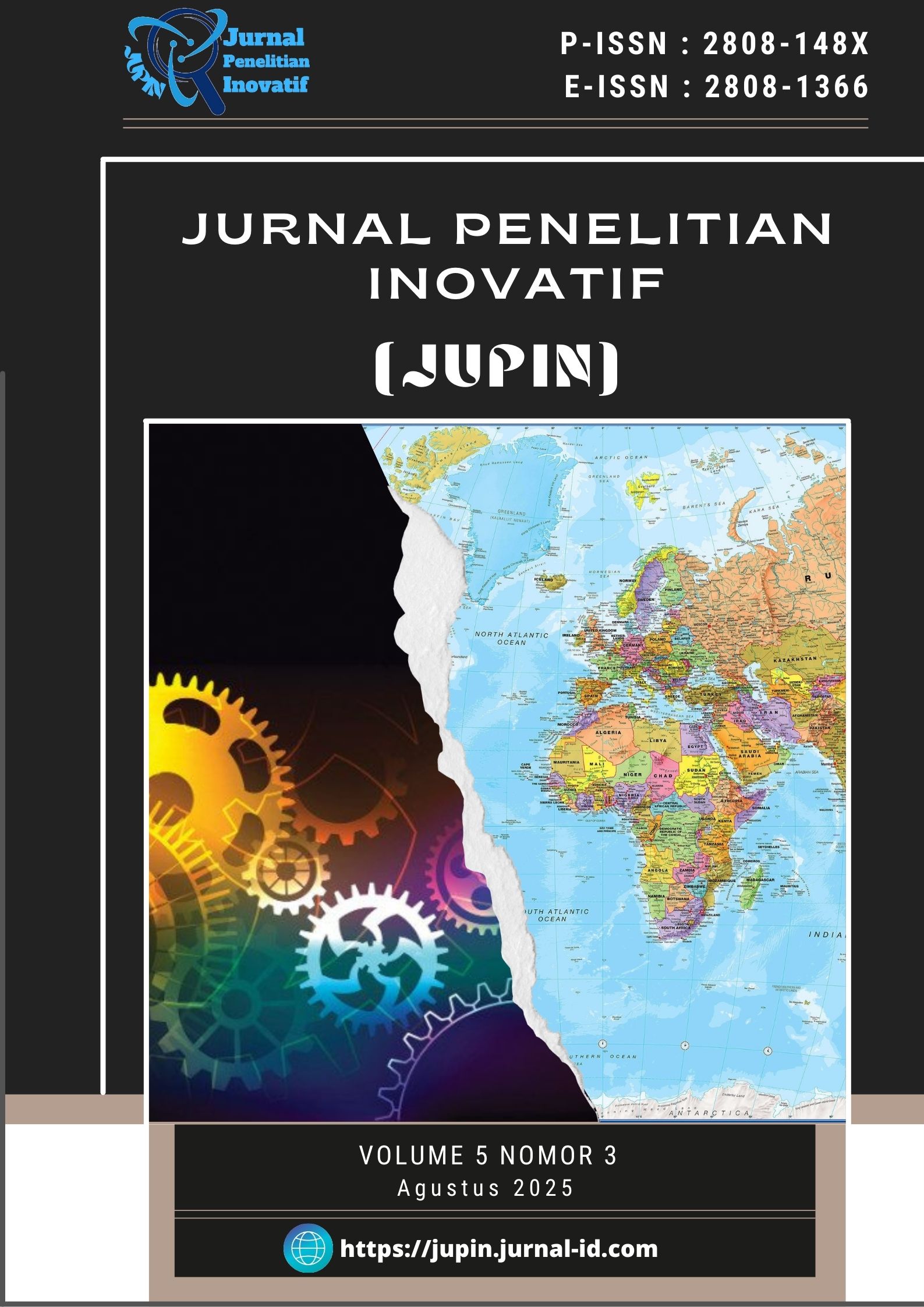Identifikasi Karakteristik Desain Temporary Modular Shelter pada Bencana di Indonesia melalui Nvivo dan Review Literatur
DOI:
https://doi.org/10.54082/jupin.1592Kata Kunci:
Infrastruktur Bencana, NVivo, Perencanaan Tanggap, Review Literatur, Temporary Modular ShelterAbstrak
Kurangnya pemahaman sistematis mengenai faktor-faktor utama yang memengaruhi desain Temporary Modular Shelter (TMS) dalam berbagai konteks kebencanaan menjadi tantangan dalam pengembangan hunian darurat yang efektif. Penelitian ini bertujuan untuk mengidentifikasi karakteristik desain TMS yang paling sering dibahas dalam literatur ilmiah internasional. Metode yang digunakan adalah systematic literature review terhadap 120 artikel yang diperoleh dari ScienceDirect, SpringerLink, dan Google Scholar. Artikel yang memenuhi kriteria inklusi dianalisis menggunakan perangkat lunak NVivo 12 melalui pendekatan thematic coding untuk mengevaluasi tema dan indikator yang paling dominan. Hasil penelitian menunjukkan bahwa kemudahan akses ke lokasi bencana (188), tingkat keterampilan tenaga kerja (178), dan logistik material (175) merupakan tiga tema dengan frekuensi tertinggi. Sebaliknya, dimensi bangunan hanya muncul sebanyak 120 kali. Temuan ini menegaskan bahwa aspek sumber daya manusia dan logistik lebih krusial dibandingkan spesifikasi teknis bangunan dalam konteks perancangan TMS. Penelitian ini berkontribusi terhadap pengembangan desain hunian darurat yang lebih adaptif, efisien, dan berbasis bukti dalam bidang teknik sipil dan perencanaan tanggap bencana.
Referensi
Ali, N. Bin, & Petersen, K. (2014). Evaluating strategies for study selection in systematic literature studies. Proceedings of the 8th ACM/IEEE International Symposium on Empirical Software Engi-neering and Measurement, 1–4. https://doi.org/10.1145/2652524.2652557
Askar, R., Rodrigues, A. L., Bragança, L., & Pinheiro, D. (2019). From Temporary to Permanent; A Circular Approach for Post-disaster Housing Reconstruction. IOP Conference Series: Earth and Environmental Science, 225, 012032. https://doi.org/10.1088/1755-1315/225/1/012032
Assyakurrohim, D., Ikhram, D., Sirodj, R. A., & Afgani, M. W. (2022). Metode Studi Kasus dalam Penelitian Kualitatif. Jurnal Pendidikan Sains Dan Komputer, 3(01), 1–9. https://doi.org/10.47709/jpsk.v3i01.1951
Corsellis, T., & Vitale, A. (2005a). Transitional settlement: displaced populations. Oxfam.
Corsellis, T., & Vitale, A. (2005b). Transitional Settlement, Displaced Populations (Vol. 7). Oxford and Cambridge: Oxfam and University of Cambridge Shelterproject.
Darcy, J. (2004). Locating Responsibility: The Sphere Humanitarian Charter and Its Rationale. Disas-ters, 28(2), 112–123. https://doi.org/10.1111/j.0361-3666.2004.00247.x
Hulathdoowage, N. D., & Hadiwattage, C. (2022). Applicability of drywall technologies for disaster-induced housing reconstruction. International Journal of Disaster Resilience in the Built Envi-ronment, 13(4), 498–515. https://doi.org/10.1108/IJDRBE-01-2021-0001
Ibrahim, R., Baranyai, B., Abdulkareem, H., & Katona, T. J. (2023). Energy Use and Indoor Environ-ment Performance in Sustainably Designed Refugee Shelters: Three Incremental Phases. Sustain-ability, 15(8), 6903. https://doi.org/10.3390/su15086903
Johnson, C. (2006). A systems view of temporary housing projects in post-disaster reconstruction. Con-struction Management and Economics, 24(4), 367–378. https://doi.org/10.1080/01446190600567977
Marji, N., & Kohout, M. (2022). From Temporary Shelter to Permanent Dwelling: Optimizing the Spa-tial Organization of Refugee Camps in Jordan through Artificial Intelligence. Proceedings of the 25th International Academic …. https://doi.org/10.1145/3569219.3569363
Martin, B., Kaminski-Ozturk, N., Smiley, R., Spector, N., Silvestre, J., Bowles, W., & Alexander, M. (2023). Assessing the Impact of the COVID-19 Pandemic on Nursing Education: A National Study of Prelicensure RN Programs. Journal of Nursing Regulation, 14(1), S1–S67. https://doi.org/10.1016/S2155-8256(23)00041-8
Perrucci, D., & Baroud, H. (2020). A review of temporary housing management modeling: Trends in design strategies, optimization models, and decision-making methods. Sustainability (Switzer-land), 12(24), 1–20. https://doi.org/10.3390/su122410388
Sari, S. N., & Nugraheni, F. (2024). Perencanaan Temporary Modular Shelter sebagai Solusi Hunian Sementara: Systematic Literature Review. G-Tech : Jurnal Teknologi Terapan, 8(1), 2632–2641. https://ejournal.uniramalang.ac.id/index.php/g-tech/article/view/1823/1229
Sari, S. N., Winarno, S., & Nugraheni, F. (2024). IDENTIFICATION OF TEMPORARY HOUSING DESIGN INDICATORS FROM THE PERSPECTIVE. 9(2), 143–152. https://doi.org/10.33579/krvtk.v9i2.5072
Vahanvati, M., McEvoy, D., & Iyer-Raniga, U. (2023). Inclusive and resilient shelter guide: accounting for the needs of informal settlements in Solomon Islands. In International Journal of Disaster Re-silience in the Built Environment. Emerald. https://doi.org/10.1108/ijdrbe-10-2022-0098
Wang, T., Huang, X., Zhao, L., Wang, Y., Zhang, S., Fu, X., Zhang, T., & Jiang, J. (2023). A biblio-metric analysis of global publication trends on rTMS and aphasia. Medicine, 102(20), e33826. https://doi.org/10.1097/MD.0000000000033826
Wu, H., Zuo, J., Zillante, G., Wang, J., & Yuan, H. (2019). Construction and demolition waste re-search: a bibliometric analysis. Architectural Science Review, 62(4), 354–365. https://doi.org/10.1080/00038628.2018.1564646
Xyrichis, A., Iliopoulou, K., Mackintosh, N. J., Bench, S., Terblanche, M., Philippou, J., & Sandall, J. (2021). Healthcare stakeholders’ perceptions and experiences of factors affecting the implementa-tion of critical care telemedicine (CCT): qualitative evidence synthesis. Cochrane Database of Systematic Reviews, 2021(2). https://doi.org/10.1002/14651858.CD012876.pub2
Young, H., & Harvey, P. (2004). The Sphere Project: The Humanitarian Charter and Minimum Stand-ards in Disaster Response: Introduction. Disasters, 28(2), 99–99. https://doi.org/10.1111/j.0361-3666.2004.00245.x
Zafra, R. G., Mayo, J. R. M., Villareal, P. J. M., De Padua, V. M. N., Castillo, Ma. H. T., Sundo, M. B., & Madlangbayan, M. S. (2021). Structural and Thermal Performance Assessment of Shipping Container as Post-Disaster Housing in Tropical Climates. Civil Engineering Journal, 7(8), 1437–1458. https://doi.org/10.28991/cej-2021-03091735
Unduhan
Diterbitkan
Cara Mengutip
Terbitan
Bagian
Lisensi
Hak Cipta (c) 2025 Sely Novita Sari, Sarwidi Sarwidi, Fitri Nugraheni, Albani Musyafa, Sely Novita Sari

Artikel ini berlisensi Creative Commons Attribution 4.0 International License.


















